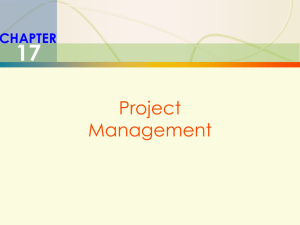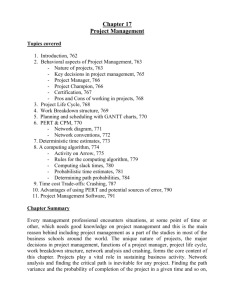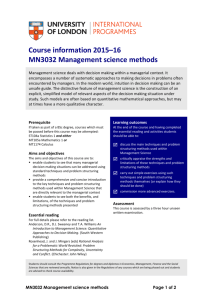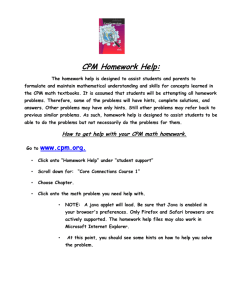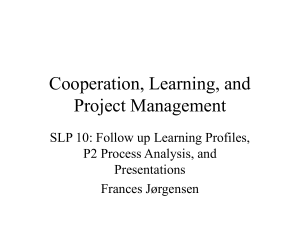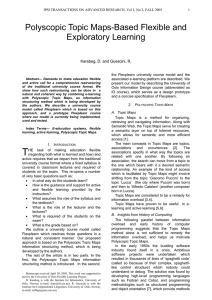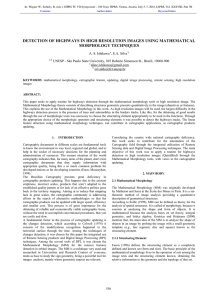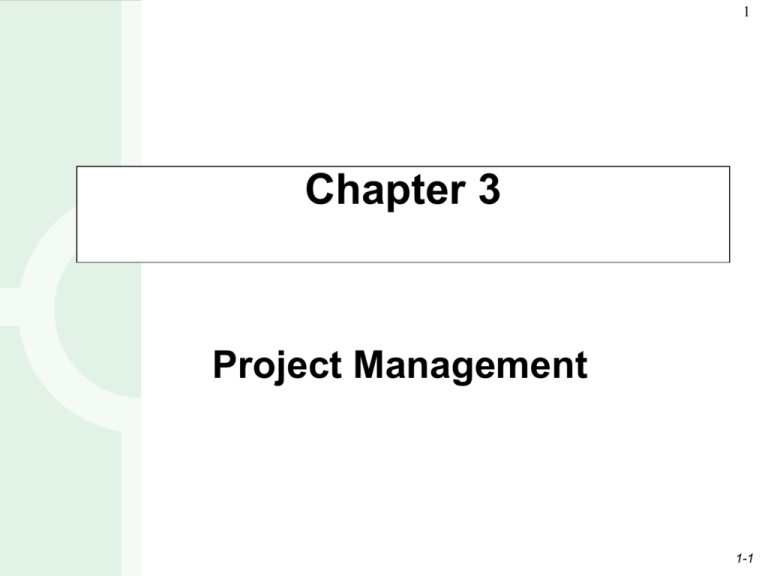
1
Chapter 3
Project Management
1-1
2
Project Management
Defined
A Project is a series of related jobs usually
directed toward some major output and
requiring a significant period of time to
perform
Project Management is the management
activities of planning, directing, and
controlling resources (people,
equipment, material) to meet the
technical, cost, and time constraints of a
project
1-2
3
Gantt Chart
Vertical Axis:
Always Activities
or Jobs
Horizontal bars used to denote length
of time for each activity or job.
Activity 1
Activity 2
Activity 3
Activity 4
Activity 5
Activity 6
Time
Horizontal Axis: Always Time
1-3
4
Pure Project
A pure project is where a self-contained team
works full-time on the project
Structuring Projects
Pure Project: Advantages
• The project manager has full authority
over the project
• Team members report to one boss
• Shortened communication lines
• Team pride, motivation, and commitment
are high
1-4
5
Structuring Projects
Pure Project: Disadvantages
• Duplication of resources
• Organizational goals and policies
are ignored
• Lack of technology transfer
• Team members have no functional
area "home"
1-5
6
Functional Project
A functional project is housed within
a functional division
President
Research and
Development
Engineering
Manufacturing
Project Project Project
A
B
C
Project Project Project
D
E
F
Project Project Project
G
H
I
Example, Project “B” is in the functional
area of Research and Development.
1-6
7
Structuring Projects
Functional Project: Advantages
• A team member can work on
several projects
• Technical expertise is maintained
within the functional area
• The functional area is a “home”
after the project is completed
• Critical mass of specialized
knowledge
1-7
8
Structuring Projects
Functional Project: Disadvantages
• Aspects of the project that are not
directly related to the functional
area get short-changed
• Motivation of team members is
often weak
• Needs of the client are secondary
and are responded to slowly
1-8
9
Matrix Project Organization Structure
President
Research and
Engineering Manufacturing Marketing
Development
Manager
Project A
Manager
Project B
Manager
Project C
1-9
10
Structuring Projects
Matrix: Advantages
• Enhanced communications between functional
areas
• Pinpointed responsibility
• Duplication of resources is minimized
• Functional “home” for team members
• Policies of the parent organization are followed
1-10
11
Structuring Projects
Matrix: Disadvantages
• Too many bosses
• Depends on project manager’s
negotiating skills
• Potential for sub-optimization
1-11
12
Work Breakdown Structure
A work breakdown structure defines the
hierarchy of project tasks, subtasks, and
work packages
Level Program
1
2
Project 1
Project 2
Task 1.1
Task 1.2
3
Subtask 1.1.1
4
Work Package 1.1.1.1
Subtask 1.1.2
Work Package 1.1.1.2
1-12
13
Network-Planning Models
• A project is made up of a sequence of activities
that form a network representing a project
• The path taking longest time through this
network of activities is called the “critical path”
• The critical path provides a wide range of
scheduling information useful in managing a
project
• Critical Path Method (CPM) helps to identify the
critical path(s) in the project networks
1-13
14
Prerequisites for Critical Path Methodology
A project must have:
well-defined jobs or tasks whose
completion marks the end of the project;
independent jobs or tasks;
and tasks that follow a given sequence.
1-14
15
Steps in the CPM with Single Time Estimate
• 1. Activity Identification
• 2. Activity Sequencing and
Network Construction
• 3. Determine the critical path
– From the critical path all of the
project and activity timing
information can be obtained
1-15
16
CPM with Single Time Estimate
Consider the following consulting project:
Activity
Assess customer's needs
Write and submit proposal
Obtain approval
Develop service vision and goals
Train employees
Quality improvement pilot groups
Write assessment report
Designation Immed. Pred. Time (Weeks)
A
None
2
B
A
1
C
B
1
D
C
2
E
C
5
F
D, E
5
G
F
1
Develop a critical path diagram and determine
the duration of the critical path and slack times
for all activities.
1-16
17
First draw the network
Act.
Imed. Pred. Time
A
None
2
B
A
1
C
B
1
D
C
2
E
C
5
F
D,E
5
G
F
1
1-17
18
Sensitivity Analysis
• What if something goes wrong?
• Can you still be able to finish the
project as planned?
1-18
19
Example 2. CPM with Three Activity Time Estimates
Immediate
Task Predecesors Optimistic Most Likely Pessimistic
A
None
3
6
15
B
None
2
4
14
C
A
6
12
30
D
A
2
5
8
E
C
5
11
17
F
D
3
6
15
G
B
3
9
27
H
E,F
1
4
7
I
G,H
4
19
28
1-19
20
Example 2. Expected Time Calculations
ET(A)= 3+4(6)+15
Task
A
B
C
D
E
F
G
H
I
Immediate Expected
Predecesors
Time
None
7
None
5.333
A
14
A
5
C
11
D
7
B
11
E,F
4
G,H
18
Expected Time =
6
ET(A)=42/6=7
Immediate
Task Predecesors Optimistic Most Likely Pessimistic
A
None
3
6
15
B
None
2
4
14
C
A
6
12
30
D
A
2
5
8
E
C
5
11
17
F
D
3
6
15
G
B
3
9
27
H
E,F
1
4
7
I
G,H
4
19
28
Opt. Time + 4(Most Likely Time) + Pess. Time
6
1-20
21
Example 2. Network
Duration = 54 Days
C(14)
E(11)
H(4)
A(7)
D(5)
F(7)
I(18)
B
(5.333)
G(11)
1-21
22
A ctivity variance,
Task
A
B
C
D
E
F
G
H
I
2
Pessim . - O ptim . 2
= (
)
6
Optimistic Most Likely Pessimistic Variance
3
6
15
4
2
4
14
6
12
30
16
2
5
8
5
11
17
4
3
6
15
3
9
27
1
4
7
1
4
19
28
16
(Sum the variance along the critical path.)
2
= 41
1-22
23
Example 2. Probability Exercise
What is the probability of finishing this project in
less than 53 days?
p(t < D)
D=53
t
TE = 54
Z =
D - TE
2
cp
1-23
24
Example 2. Additional Exercise Solution
p(t < D)
TE = 54
t
D=56
1-24
25
Time-Cost Trade-offs
-Activity crashing: reduce activity
times to complete a project earlier (at
a cost, of course)
-To reduce project completion time:
•
Focus on the critical activities!!
•
Be careful!! When you reduce the critical path,
it may no longer be the critical path anymore.
Check it again!!
1-25
26
Crashing Example
B
6
A
7
D
8
E
10
C
4
1-26
27
Crashing example
Activity
Cost per day to # of days
an
expedite
Avg.
Time
Crash
time
Normal
cost
Crash
cost
A
7
5
$70
100
(100-70)/2=15
2
B
6
3
60
80
(80-60)/3=6.67
3
C
4
2
40
60
(60-40)/2=10
2
D
8
6
80
120
(120-80)/2=20
2
E
10
7
10
40
(40-19)/3=10
3
activity
may be
shortene
d
• Q: By how many days can I expedite this project if I had a
budget of $24?
1-27
28
Project
completion
time
Critical
path
McGraw-Hill/Irwin
Cost of
Least
expediting expensive
activity
©2009 The McGraw-Hill Companies, All Rights Reserved
Cost of
LEA
1-28


